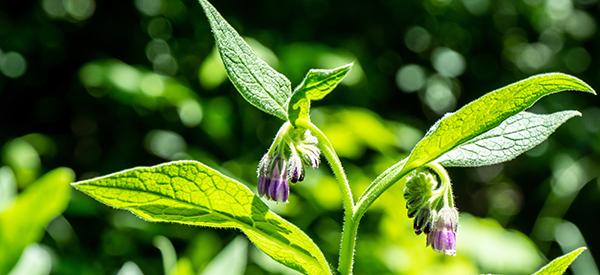
Comfrey
Comfrey (Symphytum officinale) is an attractive ornamental plant used in gardening and medicine. It is called knitbone or boneset, referring to the bone-like growth of its roots. It also came as a reference to the belief that comfrey can mend broken bones. The plant has a long history in folk and ancient herbal treatments before comfrey is deemed unsafe for consumption. There is information pertaining to its toxicity and possible risk for cancer and liver damage with unreasonable intake.
Today, comfrey is rarely used for food purposes for humans and animals. However, they are still propagated as garden ornamentals and as topical medicine. It is sold as ointments or topical salves and tinctures. It is also considered an excellent crop for mulching and organic fertilizing.
Since the early 400 BC, comfrey exists as a healing herb used by the Greeks and Romans. They used it for treating heavy bleeding, bronchial illnesses, wounds, and bone problems. The use of comfrey as food and fodder was challenged by scientific studies due to its carcinogenic properties. In 1978, Japan published a study depicting the adverse effects comfrey can cause to the liver. Thus, comfrey was temporarily restricted to be cultivated as a food crop.
Where Comfrey Is Found
Comfrey hailed from the temperate regions of Europe and Western Asia and was naturalized in the United States. This herbaceous perennial naturally thrives in cooler conditions and will survive drought and frost. Comfrey favors damp and grassy places, and they are often found lining river banks, fens, and marshes.
⇒ The Complete Map of Edible Plants: Find Out What You Have in Your Area! (Video)
How To Identify Comfrey
Showy but drooping violet flowers dot the comfrey plant during its blooming season. It grows in a dense cluster of foliage resembling a fountain of leaves. Comfrey is conspicuously hairy, but these hairs collapse when the plant wilts.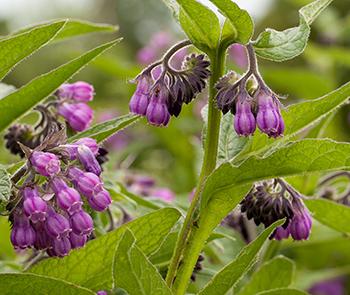
- Leaves. Comfrey leaves are green and rough because of the presence of hairs. The leaf type is simple and arranged in a rosette pattern. Each leaf is lanced or oval-shaped, and measures about 15 cm long and at least 7 to 15 cm wide. The base of the upper leaf of the comfrey runs closely attached to the length of the stem.
- Flowers. The flowers of comfrey bloom in late spring to early winter. Depending on the variety, it may have purple, creamy yellow, or white blossoms. They are bell-shaped and arranged in drooping clusters. Each flower has five petals and sepals fused into a cup or tube.

- Fruits and Seeds. The true comfrey has a relatively low seed production. Its fruits are curved and drooped downwards. As it matures, it splits into four sections or nutlets that bear the tiny seeds.
- Roots. Comfrey has an extensive root system that burrows deep into the soil. Its root is like a woody shrub that looks like a black turnip. When dried, the comfrey roots are slimy and horn-like in appearance.
- Stem. The stems of comfrey are green, winged, and hairy. It often grows to about 30 cm high that elongates rapidly to about 120 cm.
⇒ Plant Identification Guide – 400 Wild Plants That You Can Forage For (Video)
Symphytum officinale is a member of the Boraginaceae or forget-me-not family. It is an herbaceous perennial often used as a ground cover that grows in clumping and spreading habits. Comfrey is known by many names such as ass ear, blackwort, black root, boneset, knitbone, slippery root, knitbeack, and healing herb.
The S. officinale has three relevant crops:
- Symphytum officinale L., or common or wild comfrey, native to England with purple or cream-yellow flowers
- Symphytum asperum Lepechin, or Prickly comfrey, with pink or blue flowers
- Symphytum x uplandicum, or Russian comfrey, has a blue bloom and a cytotype of the common and prickly comfrey
How To Grow Comfrey
Comfrey is an uncommon crop that is often grown vegetatively because of its low seed production. Comfrey requires a chilling period to germinate. In some regions, it may take the seeds about two years to germinate. Some varieties like the Russian comfrey are sterile and will only propagate through cuttings or divisions.
Today, you may buy comfrey seed varieties from online stores that are ready for planting but may not always be viable.
More commonly, comfrey is grown from root cuttings, crown division, or transplant of an existing plant. Root cuttings are the least expensive and can also be availed online. Crown division is the fastest method to use. It will take only about ten days for the new plant to emerge.
⇒ How to Make A Self-Sufficient Backyard on 1/4 of an Acre (Video)
Growing Comfrey from Seeds
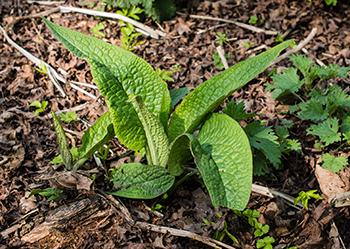 If comfrey cuttings are not available, you may still choose to grow common comfrey from seeds. Start by stratifying the seeds in the refrigerator for 30 to 60 days.
If comfrey cuttings are not available, you may still choose to grow common comfrey from seeds. Start by stratifying the seeds in the refrigerator for 30 to 60 days.
Sow the seeds outdoors before the last frost date or when the soil temperature is between 60 to 80⁰F. plant them about half an inch deep into the soil and keep the soil moist until it germinates. When it meets a favorable growing condition, the seeds may germinate in less than a month.
Growing Comfrey from Crown and Root Cuttings
Crown cuttings are the part of the plants where the stem meets the roots. Some online stores or local gardens may sell crown or root cuttings of comfrey.
If you have the parent plant, simply dig up the mature comfrey and cut across the roots about three inches from the top. The top section can be planted as crown cutting, while the lower section for root division.
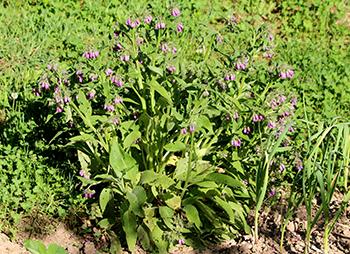 If you happen to purchase a wilted comfrey cutting, soak them in cold water for a few hours. Once firm, the cuttings are ready for planting.
If you happen to purchase a wilted comfrey cutting, soak them in cold water for a few hours. Once firm, the cuttings are ready for planting.
Lay the cuttings flat into the soil with a depth of about 2 to 6 inches, burying them up to the crown. Plant them deeper if using sand, or shallower when using clay. Root cuttings are also planted at least 2 inches deep. Space the plants at about 3 feet apart.
Water the comfrey plant regularly until the roots are established. Transplant them outdoors with ample spacing. Comfrey is invasive and can shoot everywhere, even with its broken roots. To avoid overwhelming other plants, transplant them into deep pots with good drainage.
Plant Care and Maintenance
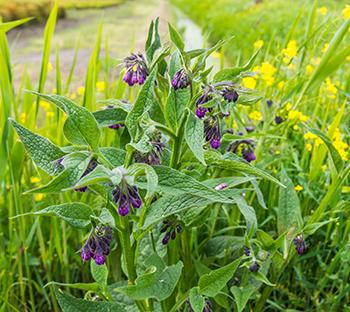
The optimum time for planting comfrey is in April, or when the soil is highly tillable. With proper weed control and good soil, the plant can last for up to 20 years.
The growing guidelines for comfrey are:
- Deep and fertile soil
- Full sunlight to partial shade
- Animal manure and nitrogen-rich mulching
- Soil pH levels between 6.0 to 7.0
- Regular watering until the plant established itself
⇒ Stopped Spending Money At The Pharmacy By Growing These 10 Plants (Video)
How To Harvest Comfrey
Comfrey blooms once every year in the late spring and early summer (sometimes, up to early winter). Harvest the plant sparingly in its first year, but it is ideal to wait until its second bloom season.
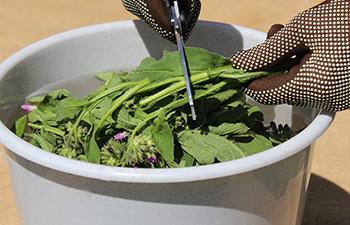 Before harvesting any parts of comfrey, make sure to wear durable gloves. The fine hairs in its stem and leaves can irritate the skin when it comes in contact with it.
Before harvesting any parts of comfrey, make sure to wear durable gloves. The fine hairs in its stem and leaves can irritate the skin when it comes in contact with it.
If you are harvesting comfrey for its leaves, cut the plant back about two inches from the crown. Comfrey is a fast-growing plant and will regrow its foliage sooner after cutting them back. If you want to use the leaves for tea or compost, harvest them before the bloom season.
The best time for gathering the comfrey roots is in late fall. Dig up the roots, scrub them well, and chop them into pieces while they are still fresh before drying them.
Dry the leaves or roots in the dehydrator or a warm oven. You may also air-dry these parts, but it may take time because they are fleshy. Comfrey is also prone to molds and wilting if they are not dried properly.
Once the comfrey is thoroughly dried, store them in an airtight container in a dark place until ready for use. Discard the dried comfrey if you notice molds feasting on its surface.
⇒ The Hidden Food Growing Fence (Video)
What Comfrey Is Good For And Natural Remedies Made From It
As a medicinal herb, the main application of comfrey is in treating fractures and inflammations. It is used to improve the healing of bruises, sprains, muscle pains, and joint pains.
Comfrey contains allantoin, an active compound that stimulates cell growth and repair. Allantoin is used in many over-the-counter medications for skin issues. It helps regrow the skin to promote faster healing of wounds. Allantoin is also useful in treating inflamed skin. It can reduce irritation caused by sunburn when applied topically.
Known for treating chronic pain, comfrey is widely used as a salve for back pains and fibromyalgia.
Comfrey is also called knitbone because of its ability to facilitate the healing of broken bones. The scientific evidence for it is still lacking. However, scientists found a substantial improvement in collagen production in topical application of comfrey.
Traditionally, comfrey is used to stop bleeding. Thus, it is effective in treating heavy menses and other pain associated with menses.
Generally, comfrey is mostly used for:
- Skin sores and irritations, wounds, eczema, sunburn
 Insect bites, sting, bedsores
Insect bites, sting, bedsores- Sprains and broken bones, fractures
- Joint and muscle pain
- Contusions
- Chest congestion
- Heavy menses
- Gout
- Mouth and gum diseases
⇒ 10 Medical Supplies You Need to Have in Your House (Video)
What Parts Of Comfrey Are Used For Remedies
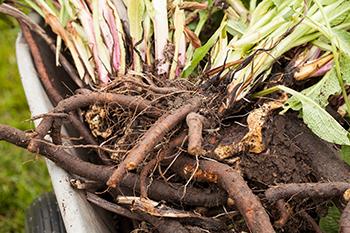 The roots, rhizome, and leaves of the plants are most valuable in traditional herbal medicine. However, because of the controversy surrounding the toxicity of comfrey, it is only limited to external use presently.
The roots, rhizome, and leaves of the plants are most valuable in traditional herbal medicine. However, because of the controversy surrounding the toxicity of comfrey, it is only limited to external use presently.
Dried leaves are used as a poultice for treating sprains, joint pains, muscle pains, and bruises. A decoction of its roots is used as a gargle or mouthwash for alleviating mouth and gum problems. When taken as mouthwash, users must take extra precautions not to ingest it.
Scientists warn the users of the potential side effect of ingesting comfrey. The plant contains pyrrolizidine alkaloids (PA) that are toxic to the liver. There are studies and research that intend to extract the compound from the plant, but it did not yield a positive result so far.
Comfrey herbal remedies are also limited to tincture, ointment, and liquid extracts. These are applied topically to alleviate pain and inflammations.
Comforting Comfrey Infused Oil
Ingredients:
- Jar (size depends on how much oil you want to make)
- Dried comfrey root (comfrey leaves can also be used)
- Carrier oil of choice (olive, sunflower coconut, grapeseed, sweet almond)
Steps:
- Fill about 2/3 of the glass jar about with dried comfrey root.

- Add the carrier oil and fill the jar all the way to the top.

- Stir the mixture gently to release air pockets and cover the jar tightly.

- Cover and label accordingly with a date.

- For a solar infusion method, place the mixture in a sunny area for about 4 to 6 weeks. Shake the jar every few days.

- After 4-6 weeks, strain the oil into another glass jar and label it.
How to use this remedy:
The comfrey-infused oil is good for external application in various inflamed and painful parts of the body. The infusion can last for many months, as long as it is kept in a cool place, away from direct sunlight. Discard the comfrey infusion once the smell becomes rancid.
Apply the oil only to unbroken skin. Accordingly, topical application of comfrey should not go for more than 10 consecutive days. It will prevent bioaccumulation of its content that may be toxic to the body.
Warnings And Cautions
Although comfrey was ingested traditionally, recent studies discovered its toxicity. Take it as a precaution and avoid taking comfrey orally.
Apply comfrey products on unbroken skin not exceeding 10 consecutive days.
Comfrey has mild interaction with liver drugs, which can increase the probability of liver damage when ingested.
The topical application of comfrey is not recommended for pregnant and breastfeeding women. You should not also use comfrey if you have a history of liver disease, cancer, or alcohol abuse. Comfrey is, likewise, unsafe for children.
You may also like:
 How To Make A Comfrey Salve For Arthritis and Joint Pain
How To Make A Comfrey Salve For Arthritis and Joint Pain
Similar to Morphine: The Best Natural Painkiller that Grows in Your Backyard (Video)
10 Things You Didn’t Know About Comfrey

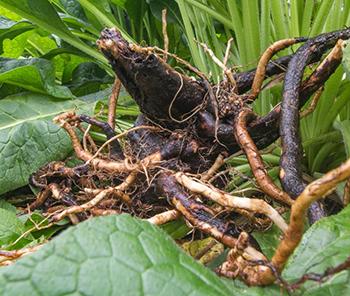
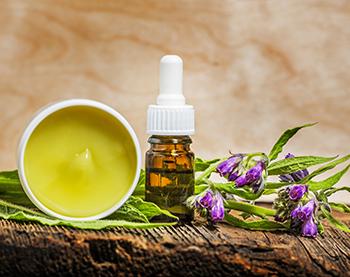 Insect bites, sting, bedsores
Insect bites, sting, bedsores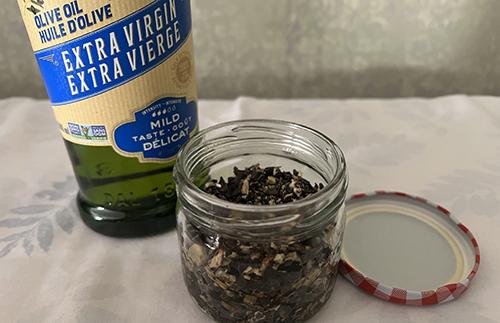
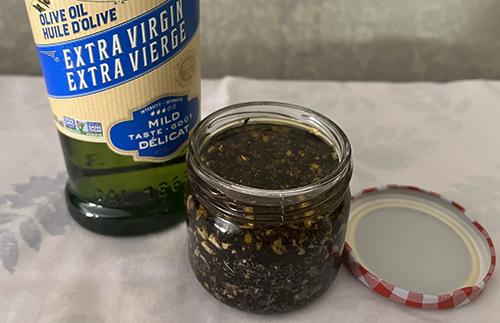
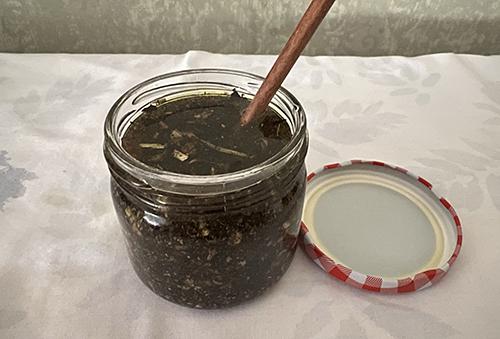
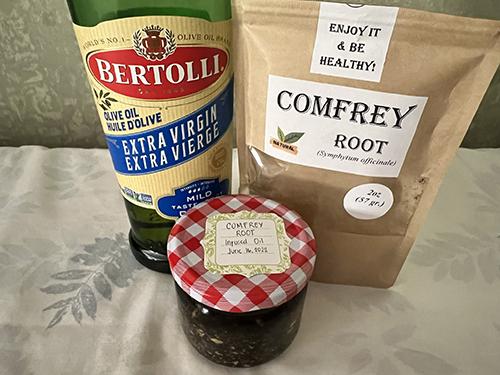
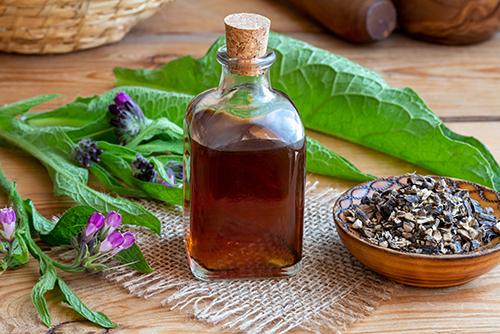
Just be warned – comfrey is MASSIVELY invasive! 🙂 Once you get it started in your yard, you will have it forever… and it spreads freely by both airborne seed and any bit of root.
It’s been highly touted as a green compost, and the bees (especially big chunky bumblebees) adore it.
There are strains that are a bit smaller and definitely less invasive. I try to cut the flowers off when they start to wilt (after the bees have had their way) to minimize seed production.
I have one that has spread NIT AT ALL. Depends on which one you get.
‘NIT AT ALL’? What does this mean, please? Do you mean “I have one that has not spread at all”?
I have the same problem with many “invasive” plants. they are spindly and often come back but never spread or take over anything (e.g. mint), so I DO think it depends on the plant, your soil/climate, etc.
This doesn’t count for the Russian Comfrey 😉
Russian comfrey only spreads through the roots and not by seeds 😊
Yes comfrey is invasive but it is an excellent coppicing plant. Just chop at the base and throw the leaves down as mulch. I love having it everywhere. My own mulch source right in the garden. Permaculture 101!
And dose it not depend on the type I think I have the German verity that dose not spread and it dosant Ive had mine in the orchard for 30 years and it has barley spread stayed in tidy clumps around the trees.
Thank you for the research and warnings.
I have had a comfrey plant in my yard for 15 years. It does not go invasive in my yard. I have a lawn mower. I think that the medical danger is caused by its ability to make our cells multiply like cancer. For me, it is just ornamental.
how do i get the plant
I could not purchase your offer on my credit card. I do not understand?? This card is my preferred method for this type of transaction. WHAT IF ANYTHING BE DONE TO FACILITATE THIS PURCHASE?
It highly concerns me to see a post with such incorrect information when I just purchased your book a couple of days ago. Common Comfrey (Symphytum officinale) and Common Boneset (Eupatorium perfoliatum) are 2 very different plants. They look nothing alike. This is extremely frustrating because I had to save for a couple months just to purchase a book that I was so excited to add to my herbal library and now I have no idea if it will be trust worthy. I am so disappointed.
They’re both refered to as boneset for entirely different reasons. Two seconds of research would tell you that.
Can you turn comfrey root oil into a salve as well?
Thank you so much